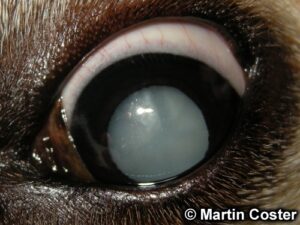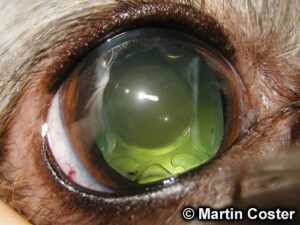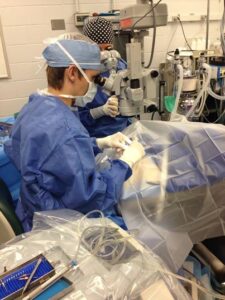-
Adopt
-
Veterinary Care
Services
Client Information
- What to Expect – Angell Boston
- Client Rights and Responsibilities
- Payments / Financial Assistance
- Pharmacy
- Client Policies
- Our Doctors
- Grief Support / Counseling
- Directions and Parking
- Helpful “How-to” Pet Care
Online Payments
Referrals
- Referral Forms/Contact
- Direct Connect
- Referring Veterinarian Portal
- Clinical Articles
- Partners in Care Newsletter
CE, Internships & Alumni Info
CE Seminar Schedule
Emergency: Boston
Emergency: Waltham
Poison Control Hotline
-
Programs & Resources
- Careers
-
Donate Now
What is a cataract?
A cataract is an opacity of the lens, the structure inside the eye responsible for focusing light. Cataracts can be any size, from very small spots that have no effects on vision, to complete cataracts that cause total blindness in an eye.

Cataract in the left eye of a diabetic dog.
What causes cataracts?
The most common causes of cataracts in dogs are genetics (or a breed predisposition) and diabetes. Other causes include old age and inflammation of the eye.
How are cataracts treated?
Treatment of cataracts is tailored to each unique individual. Often, eye drops are required to prevent or control irritation from the cataract. These help prevent discomfort that can result from having cataracts, and can also prevent more painful side effects. There are currently no eye drops that can reverse or cure cataracts. If a cataract is not interfering with vision, there may be no treatment required, but regular monitoring by an ophthalmologist is still recommended. When cataracts progress and vision is affected, cataract surgery may be an option.
What is cataract surgery?
With your pet under general anesthesia, an ophthalmologist will make a small incision in the eye, and will remove the cataract using a high frequency sound wave device. In most cases, an artificial lens is then placed, to help the eye focus. Not all eyes are able to receive an artificial lens, and animals without a lens tend to adapt very well. Your pet will need to wear an Elizabethan collar (cone) for at least 2 weeks after surgery, to protect the delicate stitches used.

Artificial lens in the right eye of a dog after successful cataract surgery.
What are the complications of cataract surgery?
All eyes that undergo surgery will need to be treated intensively with eye drops, to control the inflammation that is expected with surgery. Typically, 2 or 3 different medications are needed 4 times a day, but some cases may require treatment 6 to 8 times a day. After a few weeks, treatments are decreased; however, most cases will remain on an eye drop once or twice a day for life.
The more serious side effects of cataract surgery are glaucoma and retinal detachment. Glaucoma is an increase in pressure inside the eye. If not controlled, this can lead to pain and permanent blindness of an eye. Retinal detachment, while not painful, can also lead to complete blindness of an eye. It is important to know, however, that any of the above complications can also occur if surgery is not performed for the cataract, especially if anti-inflammatory eye drops are not used.
Can cataracts come back?
A mild amount of scarring of the lens capsule (from which the cataract is extracted and into which a false lens is often placed) is common after surgery, and does not usually interfere with vision. Lens regrowth, or “after-cataract” only occurs to a significant extent (to the point of causing vision problems) in very rare cases.
What are the alternatives to cataract surgery?
Cataract surgery is an elective procedure. Dogs with impaired vision, or even complete blindness in both eyes, adapt very well and can continue to be a happy, healthy, integral member of your family.
What follow-ups are required?
Whether you elect to have surgery performed or not, frequent visits with an ophthalmologist are recommended to monitor your pet’s eyes. If surgery is performed without complications, recheck visits are required approximately one week later, and then at 1, 3 and 6 months. Yearly rechecks with an ophthalmologist for the rest of your pet’s life are then recommended.
Is my pet a candidate for surgery?
Not all animals are candidates for cataract surgery. Since cataracts obscure our view of the back of the eye, we need to make sure that it is healthy. We do this by examining the retina in two ways. An electrical test (ERG) and an ocular ultrasound must be performed to make sure that the retina is healthy. If we remove the cataract, but the retina is not working, the eye would still be blind. The ERG and ultrasound are performed with your pet lightly sedated, as an outpatient visit. Even with normal test results pre-operatively, there is no guarantee that the retina will remain healthy throughout life. And even with normal test results, there is absolutely no obligation for you to proceed with surgery.
To schedule an appointment to have your pet examined by one of our ophthalmologists, please call 617-541-5095.
Special cataract evaluation appointments are available to give you more time to speak to the doctor.
To view a video about cataracts, produced by the American College of Veterinary Ophthalmologists, click here.
